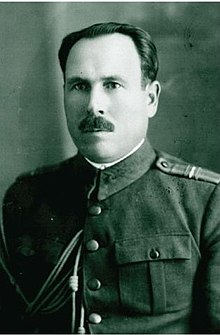Fourth Army (Romania)
In July 1941 it took part in Operation München, the recapturing of Bessarabia and Northern Bukovina, which were annexed by the Soviet Union the year before.During April–May 1944, the Romanian forces led by General Ioan Mihail Racoviță, together with elements of the German Eighth Army were responsible for defending Northern Romania during the Soviet First Jassy-Kishinev Offensive, and took part in the Battles of Târgu Frumos.On 23 August, Marshal Ion Antonescu was dismissed by King Michael I, and Romania declared war on Germany and Hungary some days later.The Soviets took control of the oilfields in the Ploiești area, and the Romanian Army was used to fight German forces on the Eastern Front.From March 1945 to June 1947, the generals in command were Nicolae Dăscălescu, Gheorghe Stavrescu [ro], Mihail Lascăr, Constantin Vasiliu-Rășcanu, and C. Nicolau.The intervention of some Warsaw Pact states in Czechoslovakia (except Romania) and the invasion of this country in August 1968, led to profound changes in the structure of 3rd Army Command.In the next year (1969), it was appreciated that the fighting capacity of the 3rd Army Command grew by over 75% from the point of view of the personnel, and about 55% in regards to military equipment.[5] The 11th Mechanised Division "Carei" reportedly consisted of the following units: Since 17 October 1990 the 4th Army Command has borne the honorary name of "Transylvania", which it also bore after the Great Union in the Hungarian–Romanian War.

RomaniaRomanian Land ForcesCluj-NapocaFirst Battle of OituzBattle of the Eastern CarpathiansBattle of PrunaruBattle of BucharestSiege of OdessaSiege of SevastopolBattle of StalingradFirst Jassy–Kishinev offensiveBattle of Târgu FrumosBattle of TurdaPrague OffensiveMarshalConstantin PrezanNicolae CiupercăGeneralMihail LascărConstantin Constantinescu-ClapsIoan Mihail RacovițăGheorghe Avramescufield armymilitary formation4th Infantry DivisionRomania in World War IRomanian CampaignWorld War IConstantin CristescuOperation BarbarossaArmy Group BOperation MünchenBessarabiaNorthern Bukovinaannexed by the Soviet UnionConstantin SănătescuRomanian Third ArmyRomanian armies in the Battle of StalingradGerman Eighth ArmyFirst Jassy-Kishinev OffensiveBattles of Târgu FrumosRed ArmyArmy Group SouthIon AntonescudismissedMichael IPloieștiRomanian ArmyEastern FrontSovietPragueHungarian 2nd ArmyGerman 8th ArmyTransylvaniaRomanian First ArmyPolish Second Army2nd Ukrainian FrontIvan KonevFirst Ukrainian FrontGeorgy ZhukovFirst Byelorussian Frontfall of BerlinCzechoslovakiaArmy Group CenterPolishpartisansIosif IacobiciIlie ȘtefleaNicolae DăscălescuBucharest1st "Tudor Vladimirescu" Volunteer Division2nd Infantry Division2nd "Horea, Cloșca și Crișan" Volunteer DivisionConstantin Vasiliu-Rășcanufloods of 19701977 Vrancea earthquakeWarsaw Pactinvasion of this countryOradeaTimișoaraTârgu MureșTargu MureșHoria, Cloșca și Crișan Division81st Mechanised DivisionBeiușGreat UnionHungarian–Romanian WarSatu MareSalontaMarghitaChișineu-Criș4th Territorial Army CorpsWayback Machine